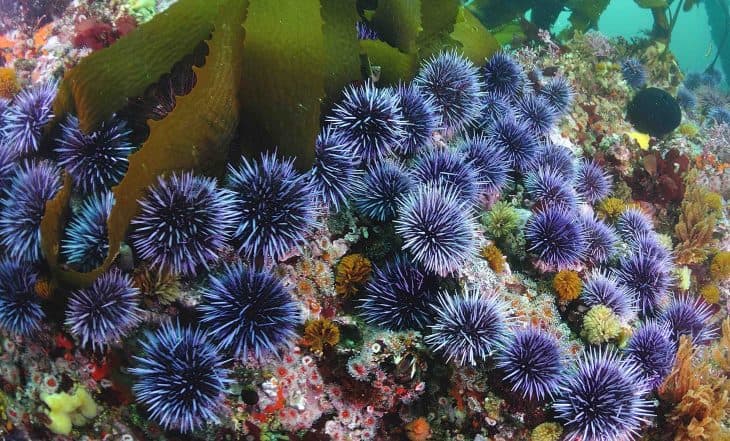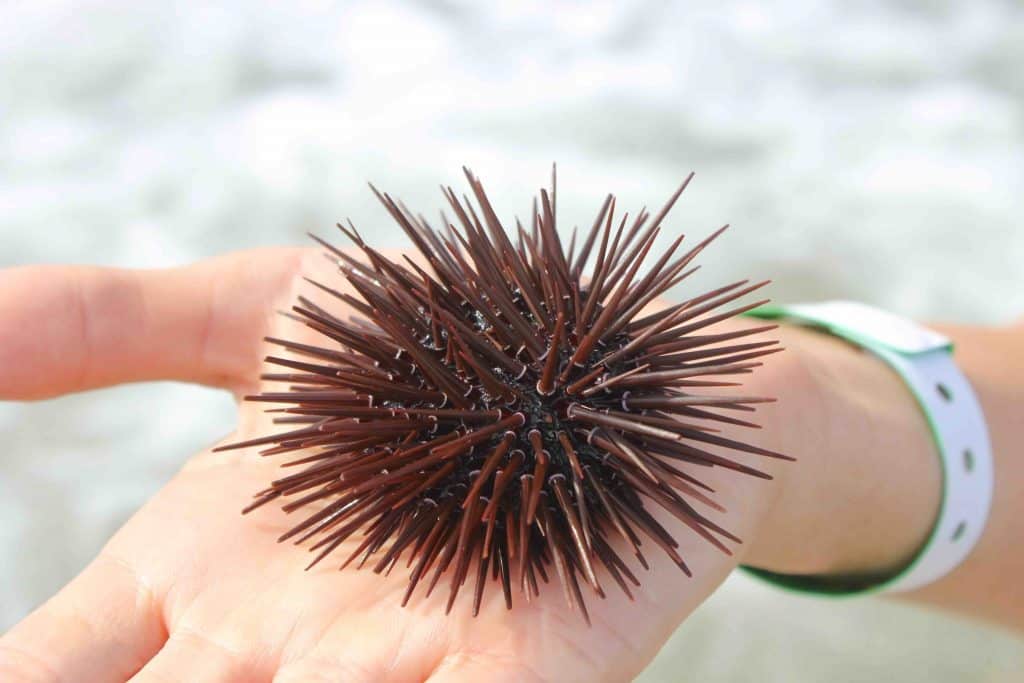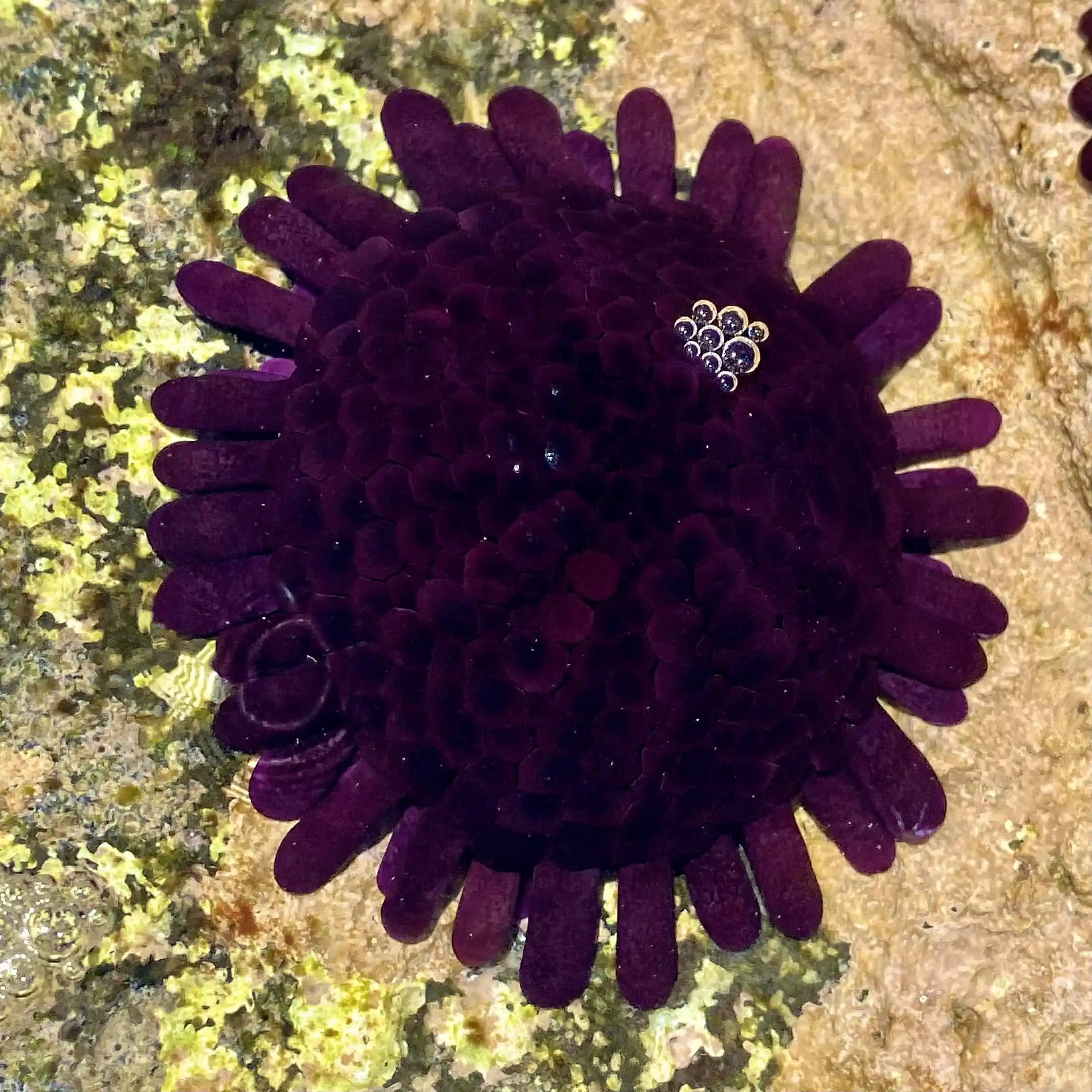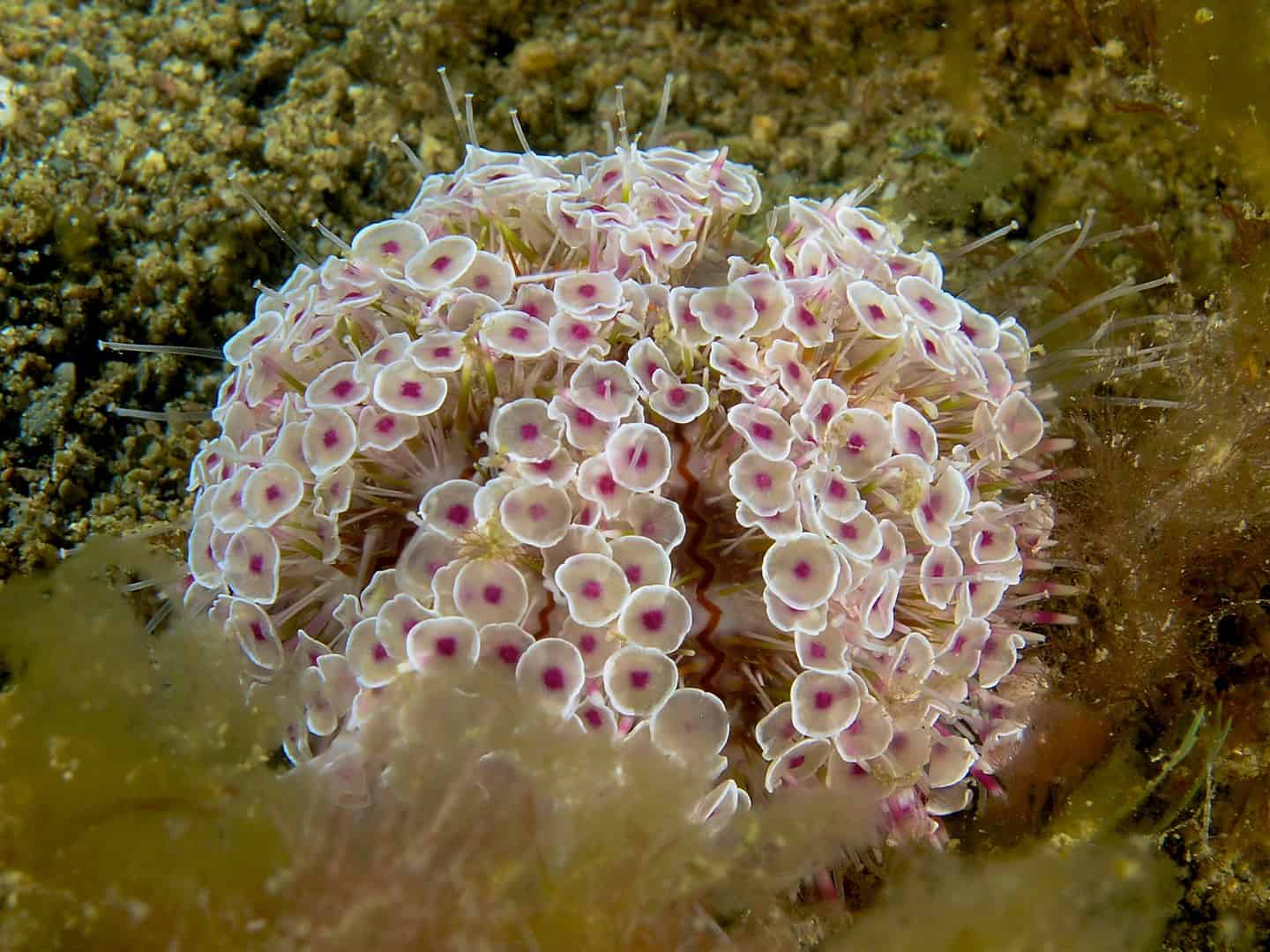
Sea urchins make up some of the most visible, and also the most fascinating animals in the sea. Their vibrant color is certainly eye-catching. Sea urchins come in many colors from purple to red, to green, etc. An average sea urchin is pretty small, around 3 to 10 centimeters in diameter. On the other hand, the biggest known sea urchin species is about 36 centimeters in diameter. Out of all the sea urchin facts, this is one that can definitely save your life- if you ever see a flower urchin underwater, you better run!
Why? The venom of a flower urchin is deadly, and can kill a human. Its venom contains a substance called Peditoxin which can cause anaphylactic shock, convulsions and death. Moreover, when a human or animal steps on or touches a flower urchin, its spines can also shatter or penetrate its flesh. Yikes!
Most sea urchins are found in warm ocean water, and hang out near coral reefs or kelp beds on the rocky ocean floor. Deadly as they may be, do you know that they have only five teeth? Their teeth are in the center of their body. Sea urchins’ teeth are made of calcium carbonate, each with their own jaw, arranged in a circle at the center of their bodies. What do they eat? Urchins mostly eat algae, which they find on rocks or reefs. They also feed on debris or decomposing matter from fish or sea creatures.
Like what you just read? Learn more about these interesting animals, with these 40 sea urchin facts.
- Modern science is aware of the existence of about an estimated 950 species of sea urchins in the world.
- Sea urchins live up to a depth of 5 kilometers under the sea.
- Most sea urchins measure around 7 centimeters across.
- The biggest sea urchins can measure up to 36 centimeters across.
- The smallest sea urchins only measure around 3 centimeters across.
- The first sea urchins evolved during the Ordovician Period, around 450 million years ago.
- These early sea urchins had thin shells compared to modern sea urchins, leading scientists to believe they evolved in calm waters.
- They also had thick, club-like spines, meant for walking on prehistoric seabeds.
- The Permian Mass Extinction nearly wiped out the sea urchins around 250 million years ago.
- Pencil urchins count themselves among the 2 survivors of the Permian Mass Extinction.
- The other survivor of the Permian Mass Extinction became the thus far unknown ancestor of all modern sea urchins.
- Sea urchins recovered, and then flourished in the Mesozoic Era.
- Most sea urchins today still have the same appearance as they did during the Mesozoic Era.
- Sand dollars, members of a specialized type of sea urchin, first evolved during the Paleogene Period, around 65 million years ago.
- They flourished in the following Neogene Period, around 23 million years ago.
- Sea urchins count sea cucumbers as their closest relatives.
- Sea urchins live in a lot of oceans all around the world.
- They share their name with the hedgehog, with ‘urchin’ coming from the French word ‘herichun’, which comes from the Latin word for hedgehog, ‘ericius’.
- Their scientific class, Echinoida, references their spines, from the Greek word for spine, ‘ekhinos’.
- Most sea urchin fossils also only include their spines.
Sea urchins have a distinctive appearance.
They have a rigid, usually spherical body, encased in a hard protective shell, surrounded by spines. The length of the spine varies from species to species, but all sea urchins can move their spines to varying degrees.
As larvae, sea urchins have bilateral symmetry, meaning you can split their bodies into two halves that mirror each other. After becoming adults, though, they develop 5-fold symmetry, meaning you can split their bodies into five sections that mirror each other.
Sea urchins have their mouths at the bottom of their bodies, and their anus on top. Some sea urchins have different shapes, though, such as the sand dollar, which has an oval shape. They also have a domed upper body, and a flat bottom, making it easier for them to burrow into the seabed.
Sea urchins actually have hundreds of feet.
At first glance, watching a sea urchin looks as though they’re just bouncing along with the water, or using their spines to move. In fact, they actually have what scientists call tube feet, small, very flexible limbs that move in and out of their shells very quickly.
Sea urchins use their own bodies’ internal water pressure to make their tube feet move. As their tube feet pump in and out of their bodies, they push the rest of their body along on the seabed. Since a sea urchin’s tube feet and spines look very similar, it’s no surprise people interchange them a lot. This creates the illusion that a sea urchin uses its spines to move.
Scientists call a sea urchin’s mouth Aristotle’s Lantern.
The name comes from the Greek philosopher and scientist Aristotle who described a sea urchin’s mouth in his book, “History of Animals.” Specifically, he described a sea urchin’s mouth as looking like a horn lantern, only with its panes removed.
However, that later proved to be a mistranslation of Aristotle’s writings, as explained by British scholar D’Arcy Thompson. Modern scholars now realize that Aristotle never actually meant to describe the sea urchin’s mouth in that passage.
Instead, Aristotle actually described the whole sea urchin, which resembled the lamps used in Greece at the time. That said, the term “Aristotle’s Lantern,” still remains in use among scientists to refer to a sea urchin’s mouth.
Sea urchins have a simple nervous system.
For one thing, they don’t actually have a brain, with their nerves instead radiating across their bodies from a neural ring around their mouths. They have five main nerves, which follow their bodies’ water vascular system that moves water across, in, and out of their bodies.
All their other nerves branch from those five nerves, heading out to the sea urchin’s mouth, spine, and tube feet. This allows the sea urchin to control its limbs and other important body parts, as well as giving them a sense of touch. They also have small organs called speridia, which sit right next to their main nerves. These organs give the sea urchin a sense for gravitational orientation, very important for balance given their usually spherical bodies.

They also have a simple reproductive method.
Sea urchins still divide themselves into two sexes, but there’s no way to tell without opening them up first. Mating season usually takes place in the spring, with sea urchins simply releasing their eggs and sperm into the surrounding water.
Fertilization thus occurs independently of the parents, with embryos usually developing within the first 12 hours. As the embryos grow into larvae, they float in the water, letting it carry them along, while they feed on phytoplankton.
It takes several months for a larva to grow into a juvenile, with the young sea urchin sinking to the seabed as its shell grows and hardens. It then takes up to 5 years for a juvenile to fully become an adult, although, they may reach sexual maturity ahead of that, in only 2 years.
Their entire body also doubles as a single compound eye.
Here’s a surprising example of Sea Urchin Facts. Light-sensitive cells actually cover their whole body, similar to an eye’s retina. They’re especially concentrated around a sea urchin’s mouth, in their spines, and in their feet. Surprisingly, though, sea urchins don’t like the light, and will actively move away from a light source.
In fact, they’ll even look for someplace dark to hide in, like under an object or in a crevice of some kind. Scientists think this behavior may have resulted in an evolutionary adaptation by sea urchins to avoid predators.
Sea urchins have preferences when it comes to their habitats.
In a surprising twist in this list of sea urchin Facts, do you know that sea urchins prefer staying in barren areas of seabed instead of thriving regions rich with undersea plant life?
Even then, the sea urchins will gather in shallower water, unless the water proves to be particularly turbulent. Then they’ll migrate to deeper water, with few exceptions like the shingle urchin, which can latch onto a rock, thus keeping itself from getting thrown around by the waves. And while sea urchins live all over the world, they prefer moderate to warm temperature, such as those in temperate and tropical regions.

Sea urchins have an omnivorous diet.
Algae make up their staple food, whether it’s simply phytoplankton all the way, to kelp, and more complex forms of algae. That said, sea urchins commonly supplement their diet with meat, usually from sea cucumber. They also prey on other animals, like brittle stars, sponges, various kinds of shellfish, and even worms.
Sea urchins can suffer from various diseases.
Scientists actually still wonder if outbreaks of disease among sea urchins exist as a natural fact, or result as a side effect of human development. Aquaculture only really began studying the field in the 1970s, with the first recorded outbreak of disease among sea urchins taking place in the 1980s.
This took the form of a bacterial spotting disease that wiped out juveniles in Japan, which came in 2 forms. First, a cool water disease that took place over the winter, and second, a hot water disease that took place over the summer.
Today, the most common disease affecting sea urchins involves what scientists call bald sea urchin disease. A bacterial infection, it takes its name from how it causes a sea urchin’s spines to fall off. It also causes sores to open up all over an infected sea urchin’s body.
They also have many predators.
Those include crabs, lobsters, otters, and various fish, all of which possess features to get around a sea urchin’s defenses. Those defenses usually involve the sea urchin’s spines, which, in some species’ cases, may contain venom. That said, crabs and lobsters just use their pincers to literally break off a sea urchin’s spines, before tearing it open.
Predatory fish just bite off the spines, before doing the same to a shell, while otters use their claws and greater strength to just swipe away at a sea urchin’s spines. Their strong jaws and sharp teeth then allow them to simply crush a sea urchin’s shell, before getting at its insides.
Sea urchins can injure people.
Their spines have enough sharpness to pierce human skin, causing puncture wounds that could be infected. Even worse, sea urchin spines tend to break off, leaving them stuck inside the person they just stung.
The brittleness of the spine also makes them difficult to remove, even for medical professionals. The spines can actually break apart even more inside the wound, causing more pain for the patient. And while sea urchin venom tends to have a mild effect on most people, some people actually have allergies to venom. This causes a severe reaction in the form of breathing difficulties, which could prove fatal without medical attention.
The flower urchin, in particular, proves especially dangerous to people.
Typically found in the Indian and West Pacific Ocean, it takes its name from its flower-like appearance. Unlike other sea urchins, the flower urchin has short and blunt spines, but this doesn’t make it any less dangerous. The danger comes from the two kinds of venom the flower urchin has. The first attacks the nerves and the blood, but isn’t especially dangerous on its own.
In contrast, the second venom isn’t poisonous at all on its own, but works to make the first venom even more poisonous. So poisonous it can cause anaphylactic shock, and even death. In fact, in 2014, the Guinness Book of World Records named the flower urchin the most dangerous sea urchin in the world.

Clownfish, though, can become immune to the flower urchin’s venom.
They do this in the same way they gain immunity from the sea anemone. Specifically, they briefly rub their bodies against the flower urchin, allowing it to poison them in small amounts. As they recover, they develop resistance, with the clownfish rubbing itself against the flower urchin longer and longer every time, until the venom does not affect them anymore.
That said, clownfish have a different reason for developing immunity to the flower urchin’s venom. They don’t live in them the way they do in sea anemones. Instead, clownfish pick at the sea urchin’s shell, eating the microscopic algae and parasites growing on the shell.
Sea urchins can devastate their surroundings.
This results when the sea urchin population grows out of control, thanks to overfishing and hunting by natural predators. Sea urchins destroy the local algae population, resulting in what scientists call urchin barrens. The name can become misleading, though, as an urchin barren isn’t actually lifeless.
Apart from sea urchins, other animals like starfish and brittle stars, among others, flourish in an urchin barren. However, underwater plant life in an urchin barren pretty much doesn’t exist, which actually starves young sea urchins of food.
Scientists find that studying sea urchins has many applications.
In particular, transparent sea urchin eggs have allowed scientists to learn much about the details of the fertilization process. The eggs also provide scientists evidence for studying prenatal development, with applications in new tests for fatal diseases. Genetic studies of sea urchin also allow scientists to discover genes usually found only in viruses, genes that can be the cause of foot-and-mouth disease.
Studies of the sea urchin’s five-fold symmetry have also given evolutionary scientists information leading to the evolution of not just the sea urchin, but of vertebrates in general, as well. Environmental scientists also find sea urchins useful in measuring the impact of global warming and ocean acidification on the underwater ecosystem.
People around the world eat sea urchins.
In Mediterranean cuisine, chefs serve sea urchin as either raw, or cooked with lemon. They’re also served as part of pasta sauce in Italian cuisine, indicated on menus as the ingredient ricci.
In other European dishes, sea urchins provide flavor to omelets, souffles, soups, and tartlets. Sea urchins also form a key ingredient in Hollandaise sauce and mayonnaise used on fish dishes. On the other side of the world, Chileans eat raw sea urchin with seasoned lemons, olive oil, and onions. And in New Zealand, sea urchins called Kina by the Maori, also get served raw.
Japan has an especially high demand for sea urchins as food.
The Japanese eat up to 50,000 tons of sea urchin, which they call uni, every year, amounting to 80% of the world’s annual sea urchin harvest. This makes for big business for sea urchin exporters in South Korea and the United States.

In addition to sea urchins, sea urchin eggs make for an expensive delicacy in Japan, with a kilo of eggs costing as much ¥40,000, or $360. In fact, Japanese demand for sea urchins has caused environmentalists to protest, arguing that it encourages overfishing of sea urchins.
Sea urchins make a good addition to an aquarium.
The Slate Pencil sea urchin proves particularly popular among marine aquarium owners. Sea urchins feed on algae, making them natural filters which can help keep aquariums clean, reducing the need for regular cleaning.
That said, owners should still remain careful when adding sea urchins to a tank, depending on what fish they share it with. Otherwise, they might find their sea urchin eaten by the fish.
Sea urchins have a place in the folklore of Northern Europe.
In particular, coastal tradition in Denmark and Southern England have varying beliefs about sea urchin fossils. One tradition, for example, considers them thunderbolts in physical form, leading to their use as amulets to protect against bad luck and the evil eye. Another tradition considers them as petrified snake eggs and also uses them as amulets to protect against various diseases.
Sea urchins in general have a stable population.
For the most part, sea urchins have surprisingly remained unaffected by changes in the environment caused by human activity. At least, not in a negative way, since, as we mentioned before, hunting and overfishing of their natural predators has caused their population to bloom.
While sea urchins generally remain under no threat, in the Mediterranean sea, the sea urchin population decreased recently. Global warming is beginning to make the water too warm even for sea urchins, which, together with water pollution has a negative effect on their local population.
Was this page helpful?
Our commitment to delivering trustworthy and engaging content is at the heart of what we do. Each fact on our site is contributed by real users like you, bringing a wealth of diverse insights and information. To ensure the highest standards of accuracy and reliability, our dedicated editors meticulously review each submission. This process guarantees that the facts we share are not only fascinating but also credible. Trust in our commitment to quality and authenticity as you explore and learn with us.
